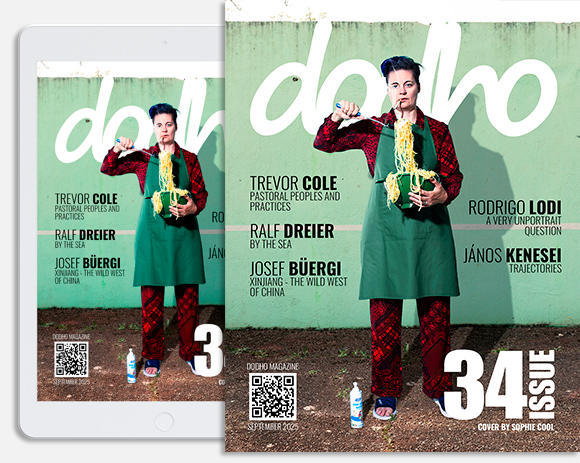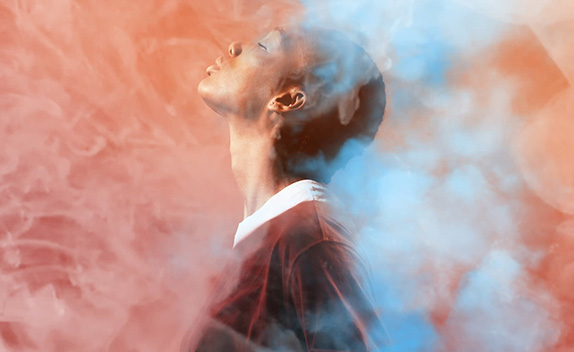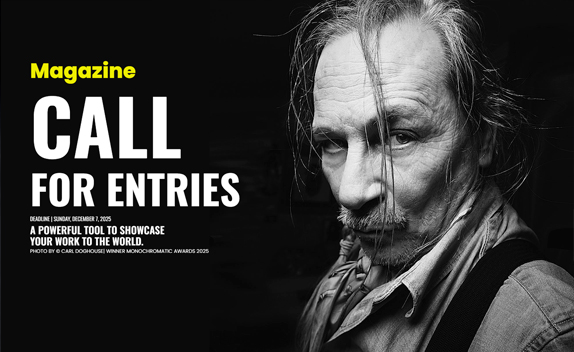Michael Kenna works in whispers. While much of contemporary photography shouts with neon palettes and towering prints, his modest silver gelatin images seldom grow larger than a sheet of notebook paper and almost always rest in shades between ink and snow.
Viewers who step close expecting spectacle discover something more enduring: a hush that invites their own breathing to slow. That hush begins long before the darkroom.
It begins in predawn fields, on empty beaches, beside forgotten factory towers, anywhere the world pauses just long enough to reveal its pulse. Kenna shows up when the pulse is faint, often around four in the morning, carrying a lightweight Hasselblad that looks archaic next to modern mirrorless rigs. He spends hours scouting a single line of shoreline or a crooked tree, waiting for fog or moon to stitch fragments of light across the scene. When the shutter finally clicks it stays open for minutes, sometimes hours, recording what the eye cannot hold: the slow brushing of clouds, the smoothing effect of tidal breath, the faint halo that gathers around distant lamps. Nothing dramatic happens, yet the negative collects a meditation.
Kenna was born in Widnes, an industrial town in northwest England known more for chemical plants than poetic vistas. Childhood memories include smoke stacks and river mist, realities that later shaped his attraction to places where man-made structures meet wild elements. He trained in commercial photography at Banbury and then at the London College of Printing, learning studio lighting and product staging, skills he rarely employs directly now yet credits for his disciplined craft. A scholarship took him to San Francisco in the late nineteen seventies, exposing him to the West Coast photographic tradition embodied by Ansel Adams and Minor White. Adams impressed him with technical exactitude, White with spiritual resonance. Kenna absorbed both influences but discarded their grand scale. He concluded that intimacy could replace drama if exposure and composition were tuned to tranquility.
That pursuit of tranquility defines his routine. He prefers winter because the sun rises late and crowds stay home. He chooses overcast skies because highlights will not burn; he chooses tidal estuaries because water erases footprints, leaving scenes unsullied by evidence of tourism. He rarely includes people, yet traces of human presence permeate his work: telephone poles aligned like prayer beads, a lone bench facing an ocean horizon, snow-covered tracks disappearing into pine forest. Such details hint at stories while refusing to settle on one narrative. The viewer becomes coauthor, filling gaps with personal memories. Kenna once said he tries to photograph not the land itself but the atmosphere that surrounds it, the intangible emotion that lingers the way perfume lingers after someone exits a room.
Technique supports that intention. Long exposures average eight minutes, though some extend beyond two hours. At night he sets the aperture around f eight, threads a cable release through gloved fingers, and listens to wind while the shutter stays open. Street lights paint silent calligraphy across lake surfaces, iron bridges glow like matchsticks, clouds blend into brushstrokes. Digital cameras could simplify the process, but Kenna remains devoted to medium format film. He cites two reasons. First, film renders highlights gracefully, allowing clouds to hold texture even when exposure is generous. Second, the delayed gratification of waiting for negatives to dry encourages distance and reflection. He often files contact sheets for months before printing, letting emotional bias fade so that selection becomes honest. Patience, he claims, is the most underrated darkroom tool.
Printing is where photographs transform into Kenna images. He works under dim amber bulbs, coaxing deep blacks with split filtration, dodging tiny highlights until they glow like embers, toning the entire sheet in selenium to extend archival life and to add subtle warmth. The result feels tactile; blacks are not empty but velvety, whites are not stark but pearlescent. When framed, the print appears to float, an object that invites closer inspection rather than immediate consumption. Collectors often describe holding a Kenna print as akin to holding a haiku, compact yet expansive.
Subject matter ranges widely. Early projects focused on French gardens and English power stations, but his passport now carries stamps from Hokkaido to Huangshan, from the Californian coastline to the cathedrals of Normandy. One constant is restraint. He avoids iconic vistas in favor of peripheral corners: a cluster of cypress trees on the edge of a Tuscan field at dusk, or wooden posts descending into Japanese hot springs, or a single smokestack mirrored in the Seine at dawn. Whenever he does photograph famous locations, he frames them in ways that strip away postcard familiarity. Mont Saint-Michel appears ghostly at low tide, its reflection melding with sand ripples; the Eiffel Tower is reduced to a silhouette dissolving into fog. Recognition flickers then recedes, leaving atmosphere behind.
Perhaps the most eloquent demonstration of his philosophy is the series on the beaches of northern France where Allied forces landed in nineteen forty four. Kenna visited sixty years later when tourism and wind had softened scars, yet his images pulse with memory. Concrete bunkers sit half submerged like prehistoric animals, barbed wire tangles emerge briefly from dunes before snow buries them again, and dawn light brushes sand in gradations that recall military maps. Without showing a single soldier or weapon, the photographs communicate the tension between beauty and trauma, testimony and forgetting. Critics call the work elegiac; Kenna counters that he merely records how places breathe decades after calamity, that serenity can carry history inside its stillness.
Commercial success arrived gradually. Galleries in Tokyo and New York hosted early shows in the eighties and nineties, but mainstream recognition grew when museums began pairing his prints with digital installations, offering viewers relief from screen fatigue. Curators noted that visitors lingered longer in his rooms than in louder sections, as if the subdued palette reset overstimulated eyes. Publishers responded with monographs: Rouge, Hokkaido, Forms of Japan, each book a portable retreat. Designers borrow his compositions for luxury branding; wellness resorts reference his tonality in spa lighting; meditation apps cite his visuals as mood boards. He remains indifferent to trends, trusting that authenticity outlasts fashion.
Despite the meditative aura, fieldwork is physically demanding. Kenna hikes with camera, wooden tripod, cable release, light meter, and several rolls of film, often in freezing wind at five in the morning. He memorizes tide tables to avoid being stranded on sand bars. In alpine regions he studies moon charts to ensure nocturnal exposures capture enough ambient glow. He jokes that sixty percent of the work happens before a single frame is exposed: walking, watching, waiting, calculating. The remaining forty percent splits between a click and months of darkroom negotiation. That arithmetic explains why his edition sizes are small, often twenty five prints per negative, and why collector demand exceeds supply.
Influence spreads quietly. Younger landscape photographers mimic his square compositions and minimalist lines, though many struggle to match the patience required. Social media hashtags teem with long exposure seascapes tinted icy blue, yet most reveal the speed of digital processing rather than the reflective depth Kenna anchors in. He does not condemn the trend; he simply reminds workshop attendees that technique without intention is decoration, and that serenity cannot be fabricated in software if chaos still roams the mind behind the camera.
Kenna’s personal demeanor mirrors his pictures. He speaks in measured cadence, pauses to consider questions, and often answers with anecdotes rather than directives. During lectures he avoids technical jargon, focusing on sensation. He recounts standing on a Japanese pier while snowflakes fell thick as pillow feathers, listening to distant fishermen chatting between casts, smelling pine from nearby forests, and how all those stimuli condensed into a negative that later became the photograph Pier and Snow. Students note that the story teaches more about awareness than about shutter speeds.
Awareness also guides his ethical stance toward the environment. He advocates for preserving fragile sites, donating prints to conservation charities, and reducing footprints by traveling light. Ironically, his most requested workshops are in Iceland, one of the most visited photo tourism destinations on earth. Rather than discourage travel he urges respect: arrive off season, explore lesser known areas, leave nothing behind. He believes photographs can foster stewardship when they reveal the sacred silence still possible in nature.
Kenna turned seventy this year yet his itinerary remains full. Upcoming projects include night studies of ancient olive groves in Puglia and an exploration of industrial relics along the Yangtze. He plans to stick with film, though he does experiment with digital contact sheets for scouting. Asked if he fears film availability in the future, he shrugs and says serenity begins inside the photographer, not inside a cassette. If film disappears he will adapt, but until then he will keep loading Ilford and watching vapor trails blur into cotton strands above estuaries at dawn.
What keeps viewers returning to his work in an era saturated with high definition bustle is its invitation to slow down. A Kenna photograph does not impose itself; it waits. Approach one and you may first see a simple pier dissolving into fog. Stay another minute and tonal gradations emerge, reflections hint at unseen depths, the eye drifts into mid-distance where shape and emptiness converse. The more you look, the less you need explanation. That experience is rare and increasingly valuable because it counters the rapid swipe culture of digital life. A collector once likened owning a Kenna print to installing a window into a parallel morning that never ends, a place where worries dissipate each time you glance at it.
In some ways Kenna’s career resembles the tidal rhythms he photographs. Early acclaim receded, leaving a quiet middle period where he refined craft away from headlines. Now the tide has returned, bringing renewed attention as audiences seek calm in visual form. He welcomes interest but resists spotlight madness, preferring to be on a misty jetty than at an art fair banquet. Fame, he says, is weather; purpose is climate. His purpose remains clear: to translate outer hush into inner stillness, one long exposure at a time.
Standing before an original print you may notice tiny imperfections: a faint scratch where a pebble struck the negative sleeve, a slight unevenness at the edge of a cloud where developer flow slowed. Kenna leaves such marks intact because they attest to process and remind viewers that serenity does not mean sterilization. Life breathes through blemishes, water ripples even when the camera renders it smooth, and photographers age though their images remain ageless on archival baryta paper. The prints endure, quietly echoing predawn silence, encouraging each beholder to linger a little longer in the gentle dialogue between light and time.






